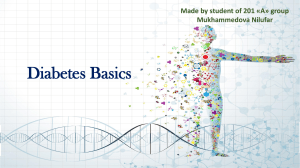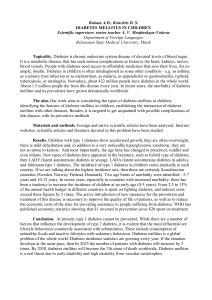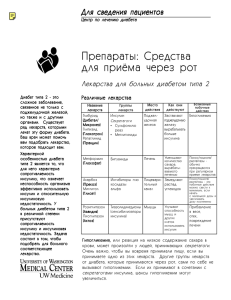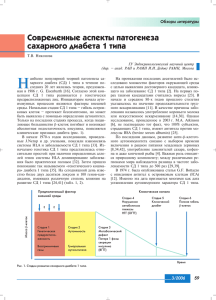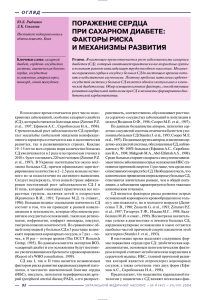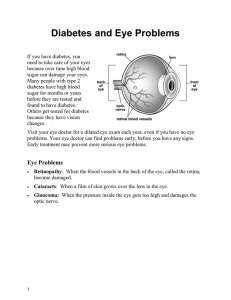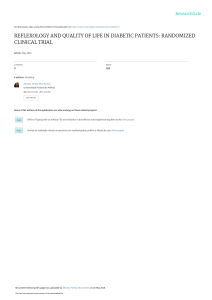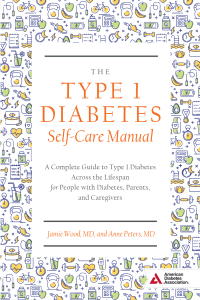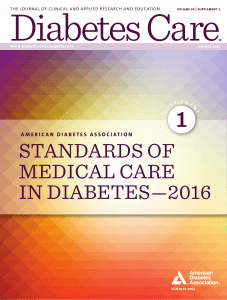treatment features of ciliary arrhythmia in patients with ischemic
реклама
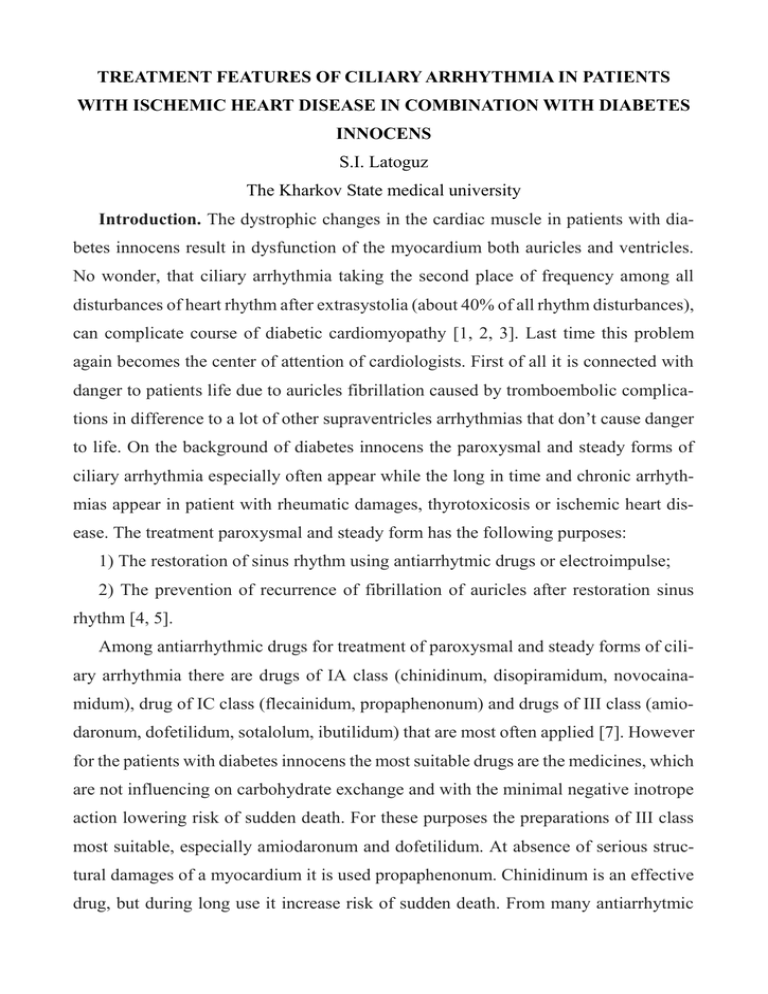
TREATMENT FEATURES OF CILIARY ARRHYTHMIA IN PATIENTS WITH ISCHEMIC HEART DISEASE IN COMBINATION WITH DIABETES INNOCENS S.I. Latoguz The Kharkov State medical university Introduction. The dystrophic changes in the cardiac muscle in patients with diabetes innocens result in dysfunction of the myocardium both auricles and ventricles. No wonder, that ciliary arrhythmia taking the second place of frequency among all disturbances of heart rhythm after extrasystolia (about 40% of all rhythm disturbances), can complicate course of diabetic cardiomyopathy [1, 2, 3]. Last time this problem again becomes the center of attention of cardiologists. First of all it is connected with danger to patients life due to auricles fibrillation caused by tromboembolic complications in difference to a lot of other supraventricles arrhythmias that don’t cause danger to life. On the background of diabetes innocens the paroxysmal and steady forms of ciliary arrhythmia especially often appear while the long in time and chronic arrhythmias appear in patient with rheumatic damages, thyrotoxicosis or ischemic heart disease. The treatment paroxysmal and steady form has the following purposes: 1) The restoration of sinus rhythm using antiarrhytmic drugs or electroimpulse; 2) The prevention of recurrence of fibrillation of auricles after restoration sinus rhythm [4, 5]. Among antiarrhythmic drugs for treatment of paroxysmal and steady forms of ciliary arrhythmia there are drugs of IA class (chinidinum, disopiramidum, novocainamidum), drug of IC class (flecainidum, propaphenonum) and drugs of III class (amiodaronum, dofetilidum, sotalolum, ibutilidum) that are most often applied [7]. However for the patients with diabetes innocens the most suitable drugs are the medicines, which are not influencing on carbohydrate exchange and with the minimal negative inotrope action lowering risk of sudden death. For these purposes the preparations of III class most suitable, especially amiodaronum and dofetilidum. At absence of serious structural damages of a myocardium it is used propaphenonum. Chinidinum is an effective drug, but during long use it increase risk of sudden death. From many antiarrhytmic drugs is the best of all amiodaronum. It has not only expressed antiarrhytmic action, but also decreases considerably risk of sudden death in the patients who have transferred infarct myocardial. It is especially important for patients with diabetes innocens, as the risk of sudden death after infarct myocardial in them is especially high [8, 9, 10]. Materials and methods. We investigated efficiency of amiodaronum in 34 patients with ischemic heart disease having paroxysmal or steady form ciliary arrhythmia. Functional possibilities of these patients corresponded to II-III functional classes. 18 patients suffered the compensated form of diabetes innocens of the 2 nd type with mild and average degree of severity. 19 patients (55.9%) have transferred the myocardium infarct earlier (in term from 6 months to 2 years). Among them there were 11 patients (32.4%) had diabetes innocens. The investigated patients had exertion stenocardia (angina pectoris) of II-III functional classes. The patients had the age of 43 to 59 years (on average 54 years). All the patients were separated in two groups: the 1st group included 16 patients with ischemic heart disease in combination with ciliary arrhythmia; the 2nd group included 18 patients having ischemic heart disease and diabetes innocens of the 2nd type and ciliary arrhythmia. Before the administration of amiodaronum all the patients were registrated with EKG (electrocardiogram), they were asked according to anamnesis. Holters monitoring and ultrasonic heart investigation had been carried out. During carrying out cardioversia amiodaronum was administered intravenously and jetly in the dose 300-450 mg within 10 minutes (the daily dose was to 1200 mg). Then amiodaronum was administered in dose 200 mg 3 times a day. Within 5-8 days, and on the 8th day 200 mg 2 times a day during 7 days. Results of research and their discussion. The analysis of results of treatment with amiodaronum has shown that cardioversion was more successful in 13 patients (81.3%) of the 1st group and in 11 patients (61.1%) of the 2nd group. The patients of the both groups treated with amiodaronum demonstrated decrease of frequency and intensity of pain attacks of angina pectoris, reduction of consumption of tablets quantity of nitroglycerine during a day. Antianginal effects of the drug were usually observed by the end of the first week after beginning of drug receiving. During treatment with amiodaronum it was observed significant decrease of heart beat rate 2 (HBR); systolic blood pressure and diastolic blood pressure has not changed. The specified effects were characteristic for the patients of the both group. According to the ultrasonic data amiodaronum did not result in reliable change of parameters of intracardiac hemodynamics. The symptoms of negative inotropic effect of this medicine were not observed. The left auricle sizes have not changed during treatment (table 1). Table 1 Effect of amiodarone on clinical angina, some indicators of cardiac hemodynamics Indicators The number of angina attacks The amount of nitroglycerin tablets Heart rate per minute Systolic blood pressure, mm Hg Diastolic blood pressure, mm Hg End-systolic left ventricular volume, cm3 End-diastolic left ventricular volume, cm3 Stroke volume, cm Ejection fraction, %* The degree of shortening of the anteroposterior size of the left ventricle during systole,% Speed circular reduce myocardial fibers, с-1 Lipoproteins, cm Group 1 (coronary heart disease) Before treatAfter 14 days ment 1,19±0,29 2,98±0,36 Р1<0,05 1,21±0,27 2,76±0,31 Р<0,05 24,92,1 20,92,8 Р>0,05 128,712,3 130,311,2 Р>0,05 76,37,5 79,46,8 Р>0,05 86,911,8 88,613,1 Р>0,05 160,719,5 159,916,3 Р>0,05 74,98,7 71,67,1 Р>0,05 46,35,6 44,93,8 Р>0,05 22,83,2 0,990,08 3,82±0,9 24,92,1 Р>0,05 1,020,06 Р>0,05 3,79±0,7 Р>0,05 2nd group (coronary heart disease + type II diabetes) Before treatAfter 14 days ment 1,40±0,24 3,32±0,41 Р<0,05 1,31±0,34 2,69±0,29 Р<0,05 60,2±4,8 86,8±5,5 Р<0,05 136,413,9 138,912,7 Р>0,05 82,38,7 85,79,3 Р>0,05 110,813,7 114,312,3 Р>0,07 189,416,1 192,715,4 Р>0,05 79,67,1 78,15,9 Р>0,05 41,73,1 40,62,3 Р>0,05 20,92,8 0,870,07 3,96±0,8 22,141,9 Р>0,05 0,880,09 Р>0,05 3,94±0,6 Р>0,05 With the purpose of prevention of fibrillation recurrence of auricles the patients continued amiodaronum reception in dose of 200-400 mg per day during 6 months. After stopping paroxysms of ciliary arrhythmia or getting rarely to 2-3 per day in 11 1 significance of differences between the indices before and after treatment. 3 patients (68.75%) of the 1st group and in 8 patients (44.4%) of the 2nd group. According to these data the antiarrhythmia activity of amiodaronum in patients with ischemic heart disease in combination with diabetes innocens of the 2 nd type was lower than in the group of patients without diabetes innocens. The reduction of efficiency of amiodaronum as antiarrhythmia drug was connected, first of all, with development and aggravation of blood circulation insufficiency. Insufficient efficiency of medicamental treatment for ciliary arrhythmia including the patients with ischemic heart disease and diabetes innocens of the 2 nd type demands development of new approaches to the choice of the treatment program. A perspective direction, as we consider, is use of drugs reducing progress of structural remodeling (inhibitors of ATF detaining potassium in an organism, blockers of angiotensin–II receptors, first of all, in patients with frequent and long attacks of fibrillation of auricles. Conclusion: 1. Amiodaronum results in expressed antiarrhythmic effect in the majority of patients with ciliary arrhythmia having ischemic heart disease and combination ischemic heart disease and diabetes innocens of 2nd type. 2. The treatment with amiodaronum does not render negative influence on cardiohemodynamics in the investigated patients. The additional useful property of this drug is the antianginal effect. 3. The preventive use of amiodaronum with the purpose the prevention of fibrillation of auricles is less effective in patients with accompayning diabetes innocens of 2 nd type. 4. For more expressed antiarrhytmic effect in case of diabetes innocens it is necessary to combine amiodaronum with renitek or lozartan, aprovelum and also potassium drugs. Literature 1. Амосова Е.Н. Метаболическая терапия повреждения миокарда, обусловленного ишемией: новый подход к лечению ишемической болезни сердца и сердечной недостаточности / Е.Н. Амосова // кардіологічний журнал. - 2000. - № 4. - с. 85-92. 4 Український 2. Бойцов С.А. Нарушения ритма сердца при хронической сердечной недостаточности / С.А. Бойцов, М.А. Подлесов // Сердечная недостаточность. 2001. - № 5 . – с . 1- 9 . 3. Дощицин В.Л. Лечение аритмий сердца / В.Л. Дощицин - М.: Медицина, 1993. – 320 с. 4. Карваух Е.В. Патогенетичний аспект кардіопротекторнoї дії антистресових засобів / Е.В. Карваух, Л.Т. Киричок // Ліки. - 1999. - № 2. - с. 7–11. 5. Кушаковский М.С. Аритмии сердца. Нарушения сердечного ритма и проводимости / М.С. Кушаковский - Руководство для врачей, 2-е изд. - СПб. 1998. - 638 с. 6. Малая Л.Т. Эффективность системной тромболитической терапии острого инфаркта миокарда и критерии ее определения / Л.Т. Малая, Я.В. Дыкун, Н.П. Копица и др. // Клиническая медицина. - 1995. - № 4. - с. 42-45. 7. Метелица В.И. Справочник по клинической фармакологии сердечнососудистых лекарственных средств / В.И. Метелица - Москва; Бином, 2002. - с. 515-518. 8. Сидоренко Б.А. Ишемия миокарда: от понимания механизмов к адекватному лечению / Б.А. Сидоренко, Д.В. Преображенский // Кардиология. 2000. - № 9. - с. 106-119. 9. Сумароков А.В. Клиническая кардиология: Руководство для врачей / А.В. Сумароков, В.С. Моисеев - М.: Универсум, 1996. - 389 с. 10. Khan M.G. Cardiac drug therapy / M.G. Khan - London: W.B. Sanders Company, 1995. - р. 149-175. ОСОБЕННОСТИ ЛЕЧЕНИЯ МЕРЦАТЕЛЬНОЙ АРИТМИИ У БОЛЬНЫХ ИШЕМИЧЕСКОЙ БОЛЕЗНЬЮ СЕРДЦА И САХАРНЫМ ДИАБЕТОМ С.И. Латогуз Нами изучена эффективность амиодарона у 34-х больных ишемической болезнью сердца, страдающих пароксизмальной или устойчивой формой мерцательной аритмии. Функциональные 5 возможности больных соответствовали II-III функциональному классу по NYHA. 18 больных страдали компенсированным сахарным диабетом II-го типа, легкой и средней степени тяжести. 19 больных (55,9%) ранее перенесли инфаркт миокарда в сроки от 6 месяцев до 2-х лет. Среди них 11 пациентов (32,4%) страдали сахарным диабетом. Обследованные пациенты страдали стенокардией напряжения II-III функционального класса. Возраст больных составил от 43 до 59 лет. Амиодарон оказывает выраженный антиаритмический эффект у большинства больных мерцательной аритмией, страдающих как ишемической болезнью сердца, так и ишемической болезнью сердца и сахарным диабетом II-го типа. Лечение амиодароном не оказывает отрицательного влияния на кардиогемодинамику у обследованных больных. Дополнительное полезное свойство препарата – антиангинальный эффект. Профилактический прием амиодарона с целью предупреждения рецидивов фибрилляции предсердий оказывается менее эффективным у больных с сопутствующим сахарным диабетом II-го типа. Ключевые слова: ишемическая болезнь сердца, сахарный диабет, мерцательная аритмия, амиодарон, апровель, лозартан. ОСОБЛИВОСТІ ЛІКУВАННЯ МИГОТЛИВОЇ АРИТМІЇ У ХВОРИХ ІШЕМІЧНОЮ ХВОРОБОЮ СЕРЦЯ ТА ЦУКРОВИМ ДІАБЕТОМ С.І. Латогуз Нами вивчена ефективність аміодарону у 34-х хворих на ішемічну хворобу серця, які страждають пароксизмальної або стійкою формою миготливої аритмії. Функціональні можливості хворих відповідали II-III функціонального класу за NYHA. 18 хворих страждали компенсованим цукровим діабетом II-го типу, легкого та середнього ступеня тяжкості. 19 хворих (55,9%) раніше перенесли інфаркт міокарда в терміни від 6 місяців до 2-х років. Серед них 11 пацієнтів (32,4%) страждали на цукровий діабет. Обстежені пацієнти страждали стенокардією напруги II-III функціонального класу. Вік хворих склав від 43 до 59 років. Аміодарон має виражений антиаритмічний ефект у більшості хворих миготливою аритмією, які страждають як ішемічною хворобою серця, так і ішемічною хворобою серця і цукровим діабетом II-го типу. Лікування 6 аміодароном не робить негативного впливу на кардіогемодинаміку у обстежених хворих. Додаткове корисна властивість препарату - антиангінальний ефект. Профілактичний прийом аміодарону з метою попередження рецидивів фібриляції передсердь виявляється менш ефективним у хворих з супутнім цукровим діабетом II-го типу. Ключові слова: ішемічна хвороба серця, цукровий діабет, миготлива аритмія, аміодарон, апровель, лозартан. TREATMENT FEATURES OF CILIARY ARRHYTHMIA IN PATIENTS WITH ISCHEMIC HEART DISEASE IN COMBINATION WITH DIABETES INNOCENS S.I. Latoguz We studied the efficacy of amiodarone in the 34 coronary heart disease patients suffering from paroxysmal or sustained atrial fibrillation. The functionality of the patients corresponded to II-III functional class NYHA. 18 patients had compensated diabetes II-type, mild to moderate severity. 19 patients (55.9%) had previous myocardial infarction within the period of 6 months of me-up to 2 years. Among them, 11 patients (32.4%) suffered from diabetes. Surveyed patients had exertional angina II-III functional class. The age of patients ranged from 43 to 59 years. Amiodarone has a pronounced antiarrhythmic effect in most patients with atrial fibrillation sufferers as coronary heart disease and ischemic heart disease and diabetes II-type. Treatment with amiodarone has no negative effect on cardiohemodynamics patients examined. Additional useful property of the drug - antianginal effect. Prophylactic administration of amiodarone for the prevention of recurrence of atrial fibrillation is less effective in patients with concomitant diabetes mellitus II-type. Key words: coronary heart disease, diabetes, atrial fibrillation, amiodarone, aprovel, losartan. 7

